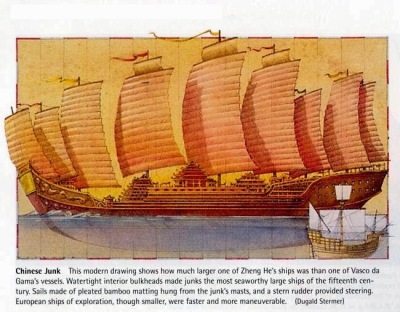According to ancient Chinese sources, Zheng He commanded seven expeditions. The 1405 expedition consisted of 27,800 men and a fleet of 62 treasure ships supported by approximately 190 smaller ships. The fleet included:
· Treasure ships, used by the commander of the fleet and his deputies (nine-masted, about 126.73 metres (416 ft) long and 51.84 metres (170 ft) wide), according to later writers. Such dimension is more or less the shape of a football field. The treasure ships purportedly can carry as much as 1,500 tons. By way of comparison, a modern ship of about 1,200 tons is 60 meters (200 ft) long, and the ships Christopher Columbussailed to the New World in 1492 were about 70-100 tons and 17 meter (55 ft) long.
· Horse ships, carrying tribute goods and repair material for the fleet (eight-masted, about 103 m (339 ft) long and 42 m (138 ft) wide).
· Supply ships, containing staple for the crew (seven-masted, about 78 m (257 ft) long and 35 m (115 ft) wide).
· Troop transports, six-masted, about 67 m (220 ft) long and 25 m (83 ft) wide.
· Fuchuan warships, five-masted, about 50 m (165 ft) long.
· Patrol boats, eight-oared, about 37 m (120 ft) long.
· Water tankers, with 1 month supply of fresh water.
Six more expeditions took place, from 1407 to 1433, with fleets of comparable size.
Trade in the Indian Ocean was decentralized and cooperative. Commercial interest prevailed over political authorities.
Strait of Malacca was the meeting point between Indian Ocean and South China Sea, between the Malay Peninsula and the island of Sumatra. The Kingdom of Siam gained control of the upper Malay Peninsula, while the Java-based Kingdom of Majapathi ruled over the lower portion of the peninsula and most of Sumatra. Majapahit was not strong enough to stop the Chinese pirates that were affecting trade in this region. In the 1407, the Chinese government sent a fleet and smashed the pirates.
The city of Alden (Arabia) had a double advantage: enough rainfall to supply drinking water to a large population and to grow grain for export and to be a convenient stopover for trade between India and the Persian Gulf, East Africa, and Egypt.
Zheng He
Forschungsmitarbeiter Mitch Williamson is a technical writer with an interest in military and naval affairs. He has published articles in Cross & Cockade International and Wartime magazines. He was research associate for the Bio-history Cross in the Sky, a book about Charles ‘Moth’ Eaton’s career, in collaboration with the flier’s son, Dr Charles S. Eaton. He also assisted in picture research for John Burton’s Fortnight of Infamy. Mitch is now publishing on the WWW various specialist websites combined with custom website design work. He enjoys working and supporting his local C3 Church. “Curate and Compile“
Leave a comment
